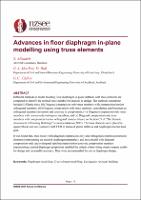Advances in Floor Diaphragm In-Plane Modelling Using Truss Elements

Download
Date
2021-04-14Authors
Alizadeh, Saeid
MacRae, Gregory
Bull, Des
Clifton, Charles
Metadata
Show full item recordAbstract
Different methods to model building floor diaphragm in-plane stiffness with truss elements are compared to identify the method most suitable for analysis in design. The methods considered include (i) Elastic truss, (ii) Diagonal compression-only truss members with compression/tension orthogonal members, (iii) Diagonal compression-only truss members, considering reinforcement as orthogonal members in tension and concrete in compression, (iv) Diagonal compression-only truss members with tension-only orthogonal members, (v) Diagonal compression-only truss members with compression/tension orthogonal members based on Section C5 of “The Seismic Assessment of Existing Buildings” recommendations (2017) and (vi) Nonlinear truss considering likely properties of the steel and concrete material. The truss elements were placed in square blocks and are compared with FEM in terms of global stiffness and diaphragm internal load path.
It was found that, truss model with diagonal compression-only and orthogonal compression/tension elements (representing un-cracked diaphragm properties), and truss model with diagonal compression-only and orthogonal reinforcement tension/concrete compression members (representing cracked diaphragm properties) satisfied the criteria of providing simple outputs usable for design and reasonable accuracy. They were recommended for use in diaphragm design.
